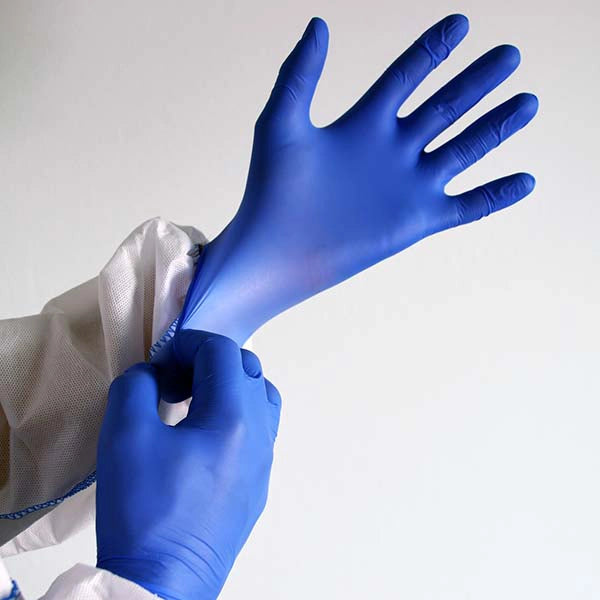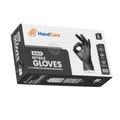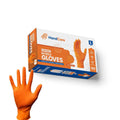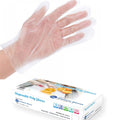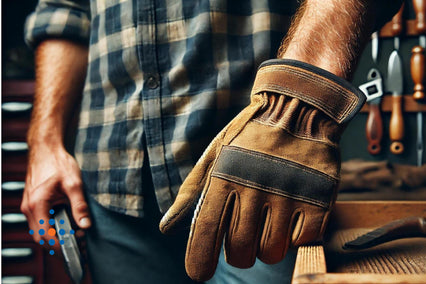Did you know that an estimated 128,000 people in the U.S. are hospitalized each year due to food borne illnesses? It’s one of the worst ways to end a meal--and the worse part is that it’s entirely preventable.
Whether you’re a home cook or a professional chef, it pays to wear the right pair of gloves.
Here’s a look at the best disposable gloves for cooking (based on our research) as well as some tips on how you can choose the perfect gloves for the occasion.
What Are Food Gloves?
Food gloves are disposable gloves specifically designed for handling food items safely and hygienically. They are used in various food service and preparation environments to prevent contamination and ensure food safety.
These gloves are made from materials such as latex, nitrile, or vinyl, which are selected for their durability and resistance to punctures and tears.
By wearing food gloves, individuals can maintain a clean and sanitary workspace, minimizing the risk of spreading bacteria, viruses, and other pathogens to food products.
5 Best Disposable Gloves for Cooking in 2025
1. HandCare Black Nitrile Gloves - Exam Grade, Powder Free (6 Mil)
These HandCare Black Nitrile Gloves are designed to offer both comfort and durability. With a 6-mil thickness, they provide enhanced protection against punctures and tears, making them a reliable choice for food handling and preparation. The gloves are powder-free, eliminating the risk of powder contamination in food, which is crucial for maintaining hygiene.
They are also latex-free, reducing the risk of allergic reactions, making them suitable for a wider range of users. The black color is popular in professional settings as it provides a sleek appearance and helps to hide stains, making the gloves look clean and professional throughout their use.
👉 Shop HandCare Black Nitrile Gloves and save up to 50% now
• Key Benefits: High durability, puncture resistance, sleek black appearance, latex-free, and powder-free.
• Ideal Uses: Perfect for tasks that require both precision and protection, such as cutting raw meats, handling acidic foods, or working with oils.
2. HandCare Blue Nitrile Gloves - Exam Grade, Powder Free (4 Mil)
The HandCare Blue Nitrile Gloves are a versatile option for those who require both protection and dexterity. With a 4-mil thickness, these gloves strike a balance between strength and tactile sensitivity, allowing for precise handling of ingredients without sacrificing protection. Being powder-free and latex-free, these gloves minimize the risk of cross-contamination and allergic reactions, making them a safe and reliable choice for food preparation.
The blue color is often used in food service environments as it is easy to spot, adding an extra layer of safety in case a glove is accidentally torn or dropped into food.
👉 Shop HandCare Blue Nitrile Gloves and save up to 50% now
• Key Benefits: Excellent tactile sensitivity, strong protection, powder-free, latex-free, and easy-to-spot blue color.
• Ideal Uses: Suitable for a variety of cooking tasks, including chopping vegetables, garnishing, and handling delicate ingredients.
3. Cranberry REVOSOFT Blue Nitrile Gloves - Exam Grade, Powder Free (2.8 Mil)
These Cranberry REVOSOFT Blue Nitrile Gloves are designed for precision and comfort. At 2.8 mil thickness, they are among the thinnest nitrile gloves available, providing unmatched tactile sensitivity that allows for the finest detail work in food preparation. Despite their thinness, these gloves still offer excellent protection against contaminants and chemicals, ensuring food safety.
The powder-free design ensures that there is no risk of powder residue being left on food, which is especially important in delicate tasks. Additionally, these gloves are sold in bulk, making them a cost-effective solution for busy kitchens that require frequent glove changes.
👉 Shop Cranberry REVOSOFT Blue Nitrile Gloves and save up to 50%
• Key Benefits: Ultra-thin design for high sensitivity, excellent chemical resistance, powder-free, and cost-effective bulk packaging.
• Ideal Uses: Best for tasks requiring high precision, such as garnishing, decorating, or working with small, delicate ingredients.
4. HandCare Orange Nitrile Gloves - Powder Free (8 Mil)
The HandCare Orange Nitrile Gloves are designed for heavy-duty kitchen tasks. With an 8-mil thickness, these gloves offer superior protection against punctures, cuts, and abrasions, making them ideal for handling sharp tools and hot foods. The gloves are powder-free, reducing the risk of contamination and ensuring that food remains safe and clean.
The bright orange color increases visibility, which is useful in preventing accidental glove loss in food or machinery. Additionally, the gloves provide excellent chemical resistance, protecting your hands from harsh cleaning agents or strong acidic foods.
👉 Shop HandCare Orange Nitrile Gloves and save up to 50%
• Key Benefits: Heavy-duty protection, high visibility, excellent chemical and puncture resistance, and powder-free.
• Ideal Uses: Ideal for demanding kitchen tasks such as cutting and chopping with sharp knives, handling hot pots and pans, or working with strong chemicals.
5. Disposable Poly Gloves Powder Free Multi-Purpose Polyethylene Gloves
These Disposable Poly Gloves are made from lightweight polyethylene, designed for quick and easy use in a variety of food handling situations. While not as durable as nitrile or latex gloves, they offer sufficient protection for short-term tasks that require frequent glove changes.
The loose fit makes them easy to put on and take off, which is perfect for high-paced environments like fast food or sandwich preparation. Being powder-free, they ensure that no powder residue is transferred to the food, maintaining cleanliness. These gloves are also latex-free, making them suitable for individuals with latex allergies.
👉 Shop Disposable Poly Gloves Powder Free Multi-Purpose Gloves and save up to 50%
• Key Benefits: Affordable, easy to use, quick to put on and remove, latex-free, and powder-free.
• Ideal Uses: Best for light food handling tasks such as making sandwiches, preparing salads, or serving ready-to-eat foods.
The Most Common Misconception About Gloves in Food Preparation
First, let’s address the most common misconception about gloves and food handling: that gloves are used to protect the worker. This may be true in your own kitchen at home, but it’s not the primary reason for wearing disposable gloves during food preparation.
The primary purpose of wearing disposable gloves is to prevent cross-contamination, the transfer of harmful bacteria from one person, place, or object to another. This often happens when switching between work tasks in a kitchen, such as preparing raw meat and preparing vegetables.
To be clear, gloves are not a catchall. The FDA is crystal clear about the need to use gloves properly, stating that gloves may actually be a source of cross contamination if used improperly.
However, the Food Code of 2017 makes the rules quite clear: workers are not allowed to touch exposed, ready-to-eat food with their bare hands and must instead use suitable utensils such as tongs, a spatula, and single-use gloves.
In other words? If you’re handling food in a professional context, you need to wear gloves.
Types of Gloves to Use for Cooking
In general, there are three main types of disposable gloves:
- Nitrile Gloves
- Latex Gloves
- Vinyl Gloves
Of the three, nitrile (a synthetic rubber copolymer) is the most durable. Latex affords the best tactile sensitivity. Vinyl is the best choice for a cheap, basic sanitary protective layer.
Latex Gloves
Latex gloves are popular in the food industry due to their flexibility, comfort, and excellent fit. They provide a high level of tactile sensitivity, making them ideal for tasks that require precision, such as garnishing or handling delicate ingredients. However, it’s important to note that latex allergies are common, so alternative gloves should be available for those who are allergic.
Nitrile Gloves
Nitrile gloves are a great alternative to latex gloves, offering similar flexibility and sensitivity without the risk of allergic reactions. These gloves are highly resistant to punctures, chemicals, and oils, making them suitable for handling raw meats, cutting vegetables, or working with acidic foods. Nitrile gloves are also durable, providing reliable protection during extended use.
Vinyl Gloves
Vinyl gloves are a cost-effective option for food handling and preparation. While they are not as durable or elastic as latex or nitrile gloves, they are suitable for tasks that require frequent glove changes, such as sandwich making or salad preparation. Vinyl gloves are free of latex proteins, making them a safe choice for individuals with latex allergies.
Polyethylene Gloves
Polyethylene gloves, also known as poly gloves, are loose-fitting and designed for quick tasks. They are commonly used in fast food settings or for serving ready-to-eat foods. While they offer minimal protection and are not as durable as other types of gloves, their low cost and ease of use make them practical for short-term tasks.
Neoprene Gloves
Neoprene gloves are heat-resistant and ideal for tasks involving hot food or liquids. They provide excellent protection against burns and are often used for handling hot pots, pans, and grills. Neoprene gloves are also resistant to chemicals and oils, making them versatile for various cooking applications.
Cut-Resistant Gloves
Cut-resistant gloves are essential for tasks that involve sharp tools, such as chopping vegetables, filleting fish, or slicing meat. These gloves are made from materials like Kevlar or stainless steel mesh, providing a high level of protection against cuts and abrasions. They allow cooks to work safely and confidently with sharp knives and other cutting instruments.
How to Choose the Best Gloves for Food Prepping
So, what are the best disposable gloves for food handling? Like anything else, it often comes down to the task in question.
For example, some food handling requires only basic sanitary protection. Other types of food preparation may require more manual dexterity and protection against punctures (such as knife handling). As such, there is no perfect glove for food prep, but some options are better than others.
Here’s how to find the right fit.
Think About the Protection You Need
The best place to start is to think about the type of protection you need. Where cooking is concerned, this is usually the choice between a basic sanitary layer to prevent cross contamination and a hardier protective layer to protect your hands from sharps injuries.
A basic sanitary layer would typically apply when you’re working with food that’s ready to eat or has already been prepared, such as chopped vegetables that are about to be cooked. In this case, your primary concern is preventing the spread of bacteria from one food item to another, or preventing the spread of bacteria from your hands to a customer.
On the other hand, if you know you’ll be working with sharp utensils or equipment, such as chopping knives, you’ll need a glove that’s designed to withstand punctures. In this case, you need the glove to be strong enough to prevent the knife or equipment from cutting through and injuring your hand.
This is important because it changes the right glove material for the job. If you need a basic sanitary layer, you’ll be best served by vinyl gloves. On the other hand, if you need a durable glove for a slightly higher price, nitrile gloves are the best choice.
Think About Allergens
Since you’re handling food that others will eat, it’s also important to think about allergens.
In this case, latex gloves are ruled out automatically. You have no way of knowing if your customer has a latex allergy, and it’s better to avoid taking the chance.
However, there are vinyl and nitrile gloves that are more allergen-friendly than others. For example, some manufacturers add latex to their gloves to make the material stretchier, and many manufacturers put powder inside latex-free gloves to make it easier to take the gloves on and off. Since you’re worried about allergens, you should stick to latex-free and powder-free gloves.
Nail Down Glove Sizing
Last but not least, pay attention to sizing.
You’ll need two measurements: measure around the widest part of your hand (excluding your thumb) and from the base of your palm to the tip of your middle finger. Take the larger of the two and look at a size chart to determine sizing.
That said, if you’re worried about fine motor skills for food presentation and you have to choose between two measurements, opt for the smaller one for your fingers. This will avoid any extra space in the tips of your fingers.
Get the Right Gloves for Cooking From gloves.com
Choosing the appropriate gloves for your cooking needs is crucial for maintaining hygiene, safety, and efficiency in the kitchen. At gloves.com, we offer a wide range of high-quality gloves to suit every culinary task, from handling delicate ingredients to managing hot surfaces.
Our selection includes latex, nitrile, vinyl, polyethylene, neoprene, and cut-resistant gloves, ensuring you have the perfect option for any cooking scenario. By sourcing your gloves from gloves.com, you can be confident in the durability, comfort, and protection they provide, helping you create a safe and sanitary kitchen environment. Plus, with our current promotion, you can save up to 50% on select glove types. Explore our comprehensive collection today, take advantage of these savings, and find the right gloves to enhance your cooking experience.
Gloves for Cooking: Frequently Asked Questions
Should I wear gloves while cooking?
Wearing gloves while cooking is not always necessary, but it can be beneficial in certain situations. Gloves help maintain hygiene, especially when handling raw meats, preventing cross-contamination. They also protect your hands from strong odors, staining, and exposure to irritating ingredients. In professional kitchens, wearing gloves is often part of food safety protocols to ensure cleanliness and prevent the spread of bacteria.
What are proper gloves for food?
Proper gloves for food handling are those that are specifically designed for food safety and hygiene. These include disposable gloves made from nitrile, latex, vinyl, or polyethylene. They should be powder-free, non-toxic, and approved for food contact. The gloves should fit well to allow for dexterity and should be changed frequently to maintain cleanliness.
Can I use nitrile gloves for cooking?
Yes, nitrile gloves are an excellent choice for cooking. They are durable, resistant to punctures, and provide a high level of protection against chemicals and oils. Nitrile gloves are also latex-free, making them suitable for people with latex allergies. They offer good tactile sensitivity, allowing you to handle ingredients with precision.
Can I use latex gloves for food?
Yes, latex gloves can be used for food handling and cooking, provided that neither you nor your guests have latex allergies. Latex gloves offer a snug fit and excellent tactile sensitivity, making them ideal for tasks that require precision. However, because some people are allergic to latex, it is essential to ensure that the use of latex gloves will not cause any adverse reactions. If there is any doubt, nitrile or vinyl gloves are safer alternatives.

